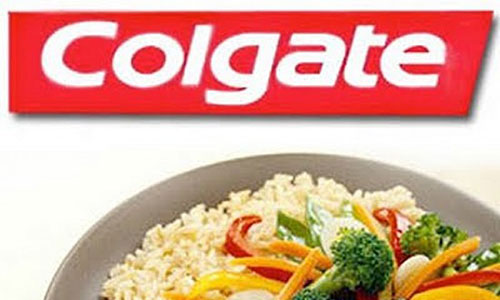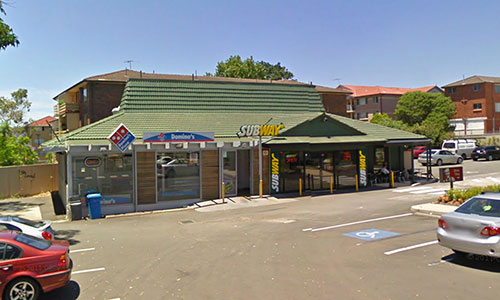Brand bastardizations
Sometimes, companies do things that go against our expectations of their brand. Often, the result can be awful. Check out these examples of brand weirdness.
Editor’s note: The GIF above is adapted from a work by SheepFilms. Check out their site over this way for more of their amazing work.

The worst brand decision, probably ever
Colgate makes some pretty useful toothpaste, don’t they? Of course they do. It’s pretty much the only thing they’re known for in 2015.
Not that toothpaste was the company’s original goal. The company has a nice long history of ensuring human cleanliness. Back in 1806, William Colgate began selling soap in New York City, eventually turning his product into one of the first mass-produced soap brands in the country. It was only in 1873 that the company started selling toothpaste—the product they eventually became known for. (The company owns Palmolive and Softsoap, among other brands, so it’s not like you’re missing out on anything by never having used Colgate soap. That said, there’s a bit of a cult around Colgate’s Octagon soap, a product that’s expensive and difficult to find these days.)
This isn’t about that. In fact, it’s about something that doesn’t get a mention on Colgate’s website at all: That time, back in the early ’80s, where Colgate decided it’d be a good idea to start selling frozen dinners, marketing them in magazines, television, and coupon books everywhere. Colgate clearly hoped it would be a hit. Instead, it became a lesson in Branding 101.
It doesn’t take an MBA to see what the problem was with this gambit. Basically, Colgate is so specifically tied to a certain kind of product that we think of that product when we see it. And when it comes to food, you don’t want to think about fluoride and spearmint.
“In some ways, it was their household name that got in their way,” blogger Rebecca Haden writes on Selling to the Masses. “Seeing the Colgate logo is enough to bring to mind not only the idea of toothpaste, but the taste. The Colgate logo superimposed on a photo of tasty vegetables makes the meal taste—in our minds—like toothpaste.”
It’d be like reading Tedium one day, and suddenly I decide to suddenly start selling you toothpaste. That’d be weird, right?
$1.3B
The amount it cost Symantec to purchase the security services offered by Verisign in 2010. Sure,they got the company’s security operations along with roughly 900 employees, but perhaps the real reason Symantec spent so much is to purchase Verisign’s checkmark, change the color to yellow,and make it their own. That probably makes it the most expensive checkmark in history. Meanwhile, Peter Norton is sitting there with his arms crossed, feeling replaced by a symbol.
Five alternate uses for famous names
- Before Nike became a massive shoe company, there was another Nike out there, and much like the company’s Air Jordans on the right feet, they were explosive. In the 1940s through the 1970s, Bell Labs worked on Project Nike, an anti-aircraft missile development plan. Both names were inspired by Nike, the Greek goddess of victory.
- In 1992, Nirvana learned the hard way that there was another band out there called Nirvana—and they beat them to the punch by more than two decades. The other Nirvana, a twee psychedelic band in an era when every band was at least a little twee and psychedelic, hadn’t released a new album since the early 1970s, but resurfaced just in time for Kurt Cobain and company to have to pay them a little settlement money. Before Cobain died, they considered releasing an album called Nirvana Sings Nirvana, which would have been either amusing or awful. (This cover of “Lithium” gives you an idea of what you’re missing.)
- A much-lamer version of the Nirvana fight involves the U.S. band One Direction and its much-more-famous British counterpart. The U.S. version of the band sounds kinda like The Fray.
- If you’re in China and looking for a drink, avoid the Budweiser. Chinese brewers have been known to recycle the bottles and replace them with their own beer (which, admittedly, probably tastes better). But that’s not even the biggest problem ABInbev faces on the trademark front. There’s a Czech beer company, Budweiser Budvar, that already owns the trademark rights to Budweiser in much of the world. So careful asking for a Budweiser in the EU, because you’re likely to get a better beer instead.
- Note to corporate rock media: Don’t let the on-air talent buy your internet domain. Back in 1993, MTV VJ Adam Curry purchased the rights to mtv.com at a time when it was unclear whether the internet was going to turn into a big, mainstream thing. MTV was even cool with it at first—Curry’s experiments with email were some of the earliest attempts to encourage the second-screen phenomenon. Problem was, it later did—and when Curry decided to leave the company, they sued him—and he later formed a company called Metaverse, a name inspired by the controversy. Here’s what Curry’s version of mtv.com looked like in 1994, at the time of the lawsuit.

Pizza Hut: an accidental architectural icon
The problem with tying very specific architecture to your brand identity is that, when you move, whoever moves in next steals that identity and carries it with them—unless they decide to gut the building entirely.
Pizza Hut has that problem. Being a chain known for its bastardization of pizza, it only makes sense that buildings across the country have become bastardizations of Pizza Huts themselves. But thanks to one intrepid blogger, some dude Pittsburgh-based named Mike Neilson, we now know that these bastardizations number in the hundreds, if not thousands. His site, Used to Be a Pizza Hut, even has a map of all the bastardizations out there.
“I don’t think they are necessarily beautiful buildings,” Neilson told_CityLab_ back in 2013. “But they mean something to us because they are so recognizable. I think that’s why a generation of people who grew up with them feel a nostalgia for them.”
Neilson’s blog highlights Pizza Hut replacements as diverse as a radio station, a Domino’s/fish and chips shop, a martial arts studio, a police station, and a pool supply store.
It’s worth noting that, despite the design prominently being featured in the logo, Pizza Hut itself doesn’t use the design anymore for its new locations. Sometimes, those locations get combined with Taco Bells.
Pizza Hut is trying to be hip these days, but maybe it should embrace the fact that it’s rectangular, with a weird little arch in the middle, and that’s what we want from it—maybe with a Pac-Man machine in the back.
Branding is a weird thing. We spend so many hours looking at it, debating what works and what doesn’t. So many things get debated when we talk about branding—the color, the emotions it inspires, the way it affects a decision, the way it rewires our brain. Hell, there’s a field of study called consumer neuroscience that’s a very serious thing.
That’s why it’s so interesting to look at the ways that brands have been mangled and reappropriated over the years. When a brand—or its imagery, at least—zags against our expectations, it does something to our brains that creates a weird little disconnect. It kinda messes with us a little bit, like a joke that we’re all in on. Considering the way that brands so often mess with our perspectives, it’s kinda fun to see them getting a taste of their own bastardized medicine. Take that, Colgate!
:format(jpeg)/2018/04/s5yz700xeqlmuc1ocglk--1-.gif)
/2018/04/s5yz700xeqlmuc1ocglk--1-.gif)

/uploads/ernie_crop.jpg)